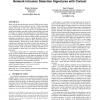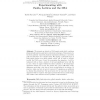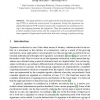98
Voted
CCS
2003
ACM
15 years 6 months ago
2003
ACM
Many network intrusion detection systems (NIDS) use byte sequences as signatures to detect malicious activity. While being highly efficient, they tend to suffer from a high false...
CCS
2003
ACM
15 years 6 months ago
2003
ACM
Forward-secure signatures (FSSs) have recently received much attention from the cryptographic theory community as a potentially realistic way to mitigate many of the difficulties...
114
Voted
ACNS
2003
Springer
15 years 6 months ago
2003
Springer
Key exposures, known or inconspicuous, are a real security threat. Recovery mechanisms from such exposures are required. For digital signatures such a recovery should ideally —an...
100
Voted
WETICE
2003
IEEE
15 years 6 months ago
2003
IEEE
Digital signatures, like physical signatures, can verify that a specific user affixed their signature to a document and they can also verify that the document is the same as when ...
EUROPKI
2004
Springer
15 years 6 months ago
2004
Springer
Despite a legal framework being in place for several years, the market share of qualified electronic signatures is disappointingly low. Mobile Signatures provide a new and promisin...
PKC
2005
Springer
15 years 6 months ago
2005
Springer
We present an attack on DSA smart-cards which combines physical fault injection and lattice reduction techniques. This seems to be the first (publicly reported) physical experimen...
102
Voted
ICICS
2005
Springer
15 years 6 months ago
2005
Springer
The concept of concurrent signatures allows two entities to produce two signatures in such a way that, the signer of each signature is ambiguous from a third party’s point of vie...
95
Voted
ICIC
2005
Springer
15 years 6 months ago
2005
Springer
Abstract. This paper presents a novel approach that uses the dynamic time warping (DTW) to match the crucial points of signatures. Firstly, the signatures are aligned through the D...
91
Voted
ASIACRYPT
2005
Springer
15 years 6 months ago
2005
Springer
Many variants of Chaum and van Antwerpen’s undeniable signatures have been proposed to achieve specific properties desired in real-world applications of cryptography. Among them...
109
click to vote
SP
2005
IEEE
15 years 6 months ago
2005
IEEE
It is widely believed that content-signature-based intrusion detection systems (IDSes) are easily evaded by polymorphic worms, which vary their payload on every infection attempt....



